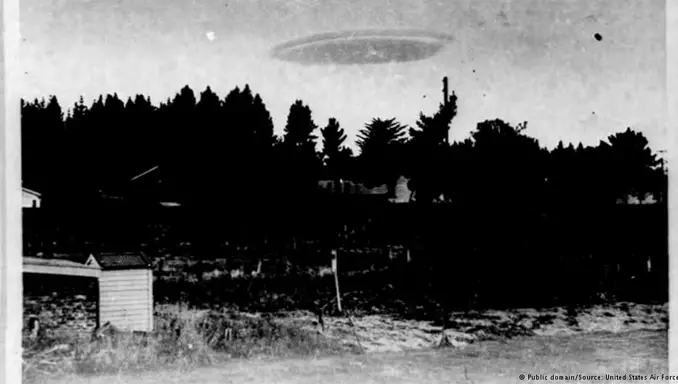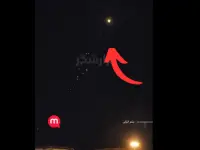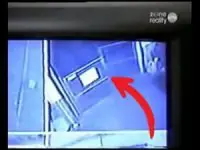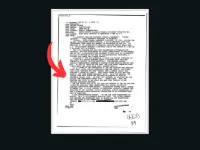Project Blue Book: it sounds like the title of a secret investigation cooked up by a mad conspiracy theorist. However, the project was actually a legitimate series of investigations conducted by the United States Air Force from 1951-1966. The purpose of this top secret project was to investigate UFO activity and other related phenomena to determine if UFO sightings were the result of natural causes or evidence of alien life. Below, take a peek into the mysterious history of this one-of-a-kind government project.
Project Blue Book Predecessors
Before Project Blue Book began its investigations, Project Sign was tasked with investigating UFO activity in America’s skies. This project began in 1947 at the request of General Nathan Twining, the chief of the Air Force Materiel Command at Wright-Patterson Air Force Base. Twining proposed the project as a result of increased public interest in UFOs.
Project Sign’s official determination was that the evidence of UFO activity was inconclusive, mostly due to lack of evidence. However, some individuals working on the project later asserted that UFOs were real and likely extraterrestrial in origin.
In 1948, Project Grudge took up the government’s UFO banner. This project, however, was initiated with the explicit purpose of debunking reports of UFOs, outraging many proponents of alien life.
Officials were unsatisfied with the conclusions and conduct of the two projects. This led them to establish Project Blue Book in 1951.
According to declassified government documents, the three projects investigated a combined total of over 12,000 sightings during the years they operated. Around 700 of those sightings were classified as “unidentified,” suggesting that researchers were unable to find a cause based on known natural or technological phenomena. This could mean that the sightings lacked sufficient evidence; it could also mean that they are true examples of extraterrestrial activity.

The Project’s Beginnings
In 1951, Captain Edward J. Ruppelt became the first head of Project Blue Book. Ruppelt was actually the first person to use the term “UFO” to refer to the phenomenon of mysterious aircraft that couldn’t be explained.
One of Ruppelt’s first aims in heading the project was to decrease the stigma that came along with UFOs. He feared that many legitimate sightings were going unreported because people feared ridicule if they came forward. To combat this, Ruppelt sought to streamline the UFO reporting process by implementing a standard questionnaire that the project’s researchers could use while questioning witnesses. He hoped that by making the process more scientific in nature, reports of UFO sightings would gain credibility. He also wanted to be able to use the data gathered from these interviews to conduct statistical analyses of UFO sightings.
The analyses conducted under Ruppelt were compiled into a report titled “Project Blue Book Special Report No. 14.” This report asserted that it was unlikely that any reports of aircraft not easily identifiable were extraterrestrial in origin. However, critics suggest that the researchers who compiled this report were pressured to come to a conclusion more acceptable by the mainstream, covering up any evidence of alien activity.
Under Ruppelt’s leadership, a number of important UFO sightings were documented and analyzed. One important and often lauded case is known as the Lubbock Lights.

This supposed UFO sighting took place in 1951 in Lubbock, Texas. The lights were seen in the Texas skies over the course of several months. While many skeptics brushed the lights off as birds or airplanes, others believed that the Lubbock Lights were a clear example of UFO activity.
The project’s official conclusion on the Lubbock Lights was that they were the result of an “unspecified natural phenomenon.” This leaves open the possibility that the lights were, in fact, extraterrestrial in origin.
Another 1951 UFO sighting came all the way from New Zealand, but can still be found in the project’s archives.

This photo depicts what appears to be a flying saucer hovering above the trees. The photo is relatively clear, eliminating the usual explanations of flaws in the film.
However, the project determined that in this case, the apparent UFO was actually a lenticular cloud. These clouds often take on the shape of a saucer, so in a black and white photograph, it is reasonable to conclude that they might be UFOs.
The Robertson Panel
In early 1952, Project Blue Book recorded and investigated hundreds of UFO sightings. This was obviously a source of much excitement for the project. What is even more exciting is that there were also signals detected on radar that coincided with the sitings, giving them an air of credibility.
This caught the attention of the CIA, which responded by forming the controversial Robertson Panel. This panel was comprised of physicists, meteorologists, engineers, and astronomers and sought to examine evidence of UFOs. The researchers of Project Blue Book presented copious amounts of evidence to the panel, but it was to no avail. The Robertson Panel concluded that the examples presented could be explained by entirely earthly factors.
Many critics accused the panel of covering up evidence or putting out false information to control public knowledge of extraterrestrial life. Regardless of the motivations, the conclusions of the Roberston Panel were a major blow to the Blue Book researchers. Their disappointment was compounded when Army-Navy-Air Force Regulation 146 was issued. This regulation forbade military personnel, including the Blue Book researchers, from discussing any aircraft activity that didn’t have a conventional, terrestrial explanation with the public. This significantly diminished the work that could be accomplished, leading Captain Edward J. Ruppelt to leave the project in 1953.
1954-1963
After Ruppelt’s departure in 1953, the project had several years that lacked meaningful activity. The next two heads of the project, Captain Charles Hardin and Captain George T. Gregory, had little faith in the existence of actual UFOs. Few actual investigations were conducted, and those incidents that did get investigated were largely brushed off as having natural or technological causes.
In 1958, Major Robert J. Friend took the helm and attempted to turn things around for the project. One major investigation during his tenure focused on a sighting in Belfast, Maine during his first year heading the project.

Images from this sighting appear to show objects in the sky shaped like saucers or mushrooms. The project launched an investigation of the sighting. Eventually, they concluded that the images could be explained by light from the star Arcturus hitting the clouds.
During Friend’s time in charge of the project, it was brought to court twice: once being accused of suppressing information, and then of performing investigations that lacked scientific merit. This led Congress to give the project a larger budget to improve its investigations.
Continue Reading on Next Page:







